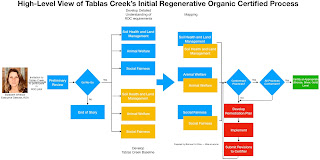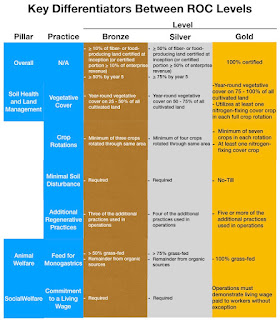Pioneering is in the DNA of Tablas Creek Vineyard -- when its founders saw the opportunity to lead with Rhone varieties in California's Mediterranean climate, they seized it -- so when the opportunity to pilot the formative
Regenerative Organic Certified (ROC) program arose, management seized it. The organization is currently positioned at the mid-level (Silver) of ROCs three-tiered schema and I am in the process of retrospectively documenting that journey. My primary sources of information for this effort were Jason Haas, Tablas Creek's Partner and General Manager, and Jordan Lonborg, the estate's Viticulturist.
The first spark of Tablas Creek's involvement in Regenerative Agriculture was lit at a wine and lamb dinner hosted by the estate. One of the attendees was the Patagonia founder (he is heavily involved in the Regenerative cause) who, according to Jason, buttonholed Neil (the Tablas Creek winemaker) for the entire evening talking about Regenerative Agriculture.
By this time, the ROC pilot was underway but the winery entrant dropped out, prompting a search for a replacement. Elizabeth Whitlow, Executive Director of the Regenerative Organic Alliance placed a call to Jason inviting the estate's participation. That phone call kicked off the process illustrated below.
After an initial review, Tablas Creek responded positively to the invitation. According to Jason, they found the program attractive because:
- It separated the soil health and biodiversity pieces from the "mystical" elements of biodynamics
- It was more measurable. It was not enough to say that you were capturing carbon in the soil -- you had to measure it
- It forced them to take "a more big-picture look" at what they were doing in areas such as resource-use reduction and animal and human welfare (It was not just about wine and soil)
- They had to be a lot more intentional about their reporting.
Soil Health and Land Management
The Tablas Creek baseline was
detailed in a prior post. The estate's prior work in organics and biodynamics meant a fairly tight mapping to the Soil Health and Land Management pillar requirements of the ROC; except for one case. The one area that was the source of extensive (ongoing) discussion was the tillage requirement.
Organic farming allows for conservation tillage but the ROC specification calls for minimal soil disturbance -- in essence, no-till. The conflict is illustrated in the chart below.
Tablas Creek tills its dry-farmed blocks. According to Jordan,
Tillage in the dry-farmed blocks is crucial due to the high clay content in our soil. Without some sort of soil disruption (as the soils dry out after the winter rains) large, deep cracks form, allowing precious moisture to evaporate into the atmosphere. We create what is known as a dust mulch layer by breaking up the top 3 to 4 inches of soil into finer particle sizes thus preventing any form of shrinking.
Tablas Creek has been given a temporary variance in the area but, according to Jason, this is one of the items that is preventing their ascension to ROC Gold. "We've been going back and forth with the certifier to make the case that, in an arid climate, there are certain sorts of tillage that are beneficial because they create a dust mulch layer and our data show that we are still adding as much carbon to the soil as we do in no-till blocks."
Regenerative farming is focused on getting carbon fixed in the soil and the farm is definitely a part of the solution. This focus, however, should not deflect the estate from examining the other contributors to its total carbon footprint; items such as renewables, packaging, transport, and sourcing of inputs (Jason).
Measurement and Testing
There is an annual testing regime which looks at organic and biodynamic practices. There is also testing as it relates to carbon in the soil with an emphais on improvements in cropped areas. Testing of soil samples are required every three years with Tablas Creek's next test due in 2023.
Animal Welfare
No gaps here. They picked up an additional certification and are now Animal-Welfare-approved.
Social Welfare
What separates ROC from most other certification programs is its Social Welfare pillar and the work in this area seems to have been one of the most challenging, meaningful, and fulfilling parts of the exercise for the folks at Tablas Creek.
According to Jordan, there are maybe three organizations in the country that do third-party certification for social welfare but they only deal with large organizations. Tablas Creek eventually set up a training program with the Equitable Food Initiative -- a group seeking to ensure the social welfare of farm workers -- in an attempt to get at the social welfare gaps. Management and workers participated in a week of intensive training to include team-building, communications, and problem-solving skills.
The training showed that communications was the biggest gap at Tablas Creek. The estate had a top-down management approach with workers assigned tasks without relevant knowledge as to the broader implications and impacts of the effort. A lot of the workers have been there 10 - 15 years and are in possession of knowledge that is not being leveraged for the good of the estate.
To address this gap, Tablas Creek established weekly round-table meetings which have empowered the workers and given them a newfound sense of ownership and responsibility. Jordan has seen a lot of good coming out of this process:
- Educating the workers as to their rights on the property and as farm workers
- Educating them on basic human rights
- Commitment to a living wage based on your geographic area (Tablas Creek is investigating).
The living wage is the second area that Tablas Creek needs to successfully address in order to be classified Gold. According to Jason there has been "a surprise increase in the living wage calculation beyond what it was last year" and that has the potential, if implemented, "to add some $150,000 to our labor costs."
The Social Welfare pillar "brought it home" for Jordan. In his view this kind of a look was long past due as exploitation of the farm worker is the "dark side" of agriculture; ROC addresses that. In addition, with the frameworks they have put in place, ideas now come from all parts of the company.
According to Jason, this overall exercise has yielded very little in terms of soil health and wine profile, given where they are in those regards. Where it has been significant has been in a recognition of the farmworker
- It has provided a new framework for crew management ,with weekly round table meetings (and these meetings have yielded benefits)
- The team members feel a sense of ownership and there is more of a relationship
- Management has had to be cognizant of the team-building required to support a flatter organization.
****************************************************************************************************
Tablas Creek has no regrets about embarking on this journey. Rather, they are happy and encouraged at the way things have played out and are giving advice to interested farms. ROC is in a good place and Tablas Creek will contribute in any way that they can to make sure that it stays that way.
©Wine --
Mise en abyme
























